About myself: |
I am an ecologist and conservation biologist with a particular interest in weta (Orthoptera: Anostostomatidae).
Research interests:
-
Diet and foraging, including isotope and nutrient analyses and food web biology. Current work is on the tree weta group Hemideina spp. We are investigating intra-specific and inter-specific differences in tree weta diet and ecological niches, and likely reasons for these differences.
-
Human dimensions of conservation, including cultural management of resources, traditional ecological knowledge, and urban ecology. One current project investigates links between biological and cultural diversity.
-
Recently, we have submitted a number of papers on tree weta ecology, including sex ratio and seasonal behaviour.
|

|
Publications
Wehi P.M., Jorgensen M. & Morgan-Richards M. (in revision). Sex and seasonal movement in a flightless forest insect the Auckland tree weta. New Zealand Journal of Ecology
Wehi P.M., Whaanga H. & Trewick S. 2012. Artefacts, biology and bias in museum collection research. Molecular Ecology. Now online.
Wehi P.M., Nakagawa S., Trewick S. & Morgan-Richards M. 2011. Does predation result in adult sex ratio skew in a sexually dimorphic genus? Journal of Evolutionary Biology 24:2321-2328 [featured on the cover, issue 24 (11)]. doi: 10.1111/j.1420-9101.2011.02366.x
Griffin, M.J., Trewick S.A., Wehi P.M. & Morgan-Richards M. 2011. “Invertebrate mice”: Exploring the concept of niche convergence in a land without rodents. New Zealand Journal of Ecology 35: 302-307.
Wehi P.M. & Hicks B.J. 2010. Isotopic fractionation and trophic enrichment in the Auckland tree weta, a large herbivorous insect. Journal of Insect Physiology 56: 1877–1882.
Wehi P.M. & Wehi W.L. 2010. Traditional plant harvesting in contemporary fragmented and urban landscapes. Conservation Biology 24: 594-604.
Wehi P.M. 2009. Indigenous ancestral sayings contribute to modern conservation partnerships: examples using Phormium tenax. Ecological Applications 19:267–275.
Wehi P.M., Whaanga H. & Roa T. 2009. Missing in translation: Maori language and oral tradition in scientific analyses of traditional ecological knowledge. Journal of the Royal Society of New Zealand 39 (4): 139-149.
Mackay D.B., Wehi P.M & Clarkson B.D. 2009. Evaluating restoration success in urban forest plantings in Hamilton, New Zealand. Urban Habitats 6: online journal. http://www.urbanhabitats.org/v06n01/hamilton_full.html. |
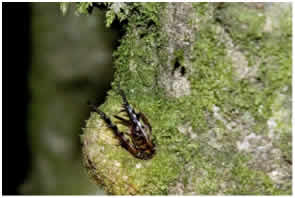
Tree weta poised in a natural cavity at night prior to emergence
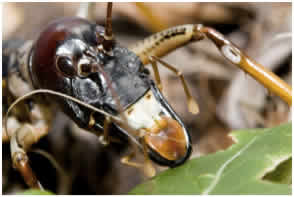
CLICK ON PICTURE
A male tree weta (Hemideina thoracica) showing the large mandibles he uses to fight with other males. Photos: David Wheadon. |
Wehi P. M. & Clarkson B. D. 2007. Biological flora 10. Phormium tenax in New Zealand (Hemerocallidaceae): harakeke, New Zealand flax. New Zealand Journal of Botany 45: 521- 544.
Clarkson B.D., Wehi P.M. & Brabyn L.K. 2007. A spatial analysis of indigenous cover patterns and implications for ecological restoration in urban centres, New Zealand. Urban Ecosystems 10: 441-457.
Wehi P. M. 2006. Kuta (Eleocharis sphacelata, Cyperaceae), a locally important and highly valued weaving plant in Northland. Journal of Maori and Pacific Development 7 (2): 39-44.
Wehi P.M., Barrell G.K. & Hickling G.J. 2006. Hormonal correlates of social rank in an asocial species, the common brushtail possum (Trichosurus vulpecula). Ethology 112: 639-648.
McAllum P.M. 2005. Care and development of pā harakeke in 19th century New Zealand: voices from the past. Journal of Maori and Pacific Development 6 (1): 2-15.
Jolly, S. E., Scobie, S., Spurr, E. B., McAllum, C. & Cowan, P. 1998. Behavioural effects of reproductive inhibition in brushtail possums. In: Biological control of possums: report of a workshop sponsored by the National Science Strategy Committee for Possum & Bovine TB Control, 21-23 April 1997, Lynch, R. ed. Royal Society of New Zealand Miscellaneous Series 45: 125-127.
Selected Awards
2009 Finalist, Emerging Scientist Award, Kudos Hamilton Science Awards. Please see video interview here
2008 ISAT Royal Society of New Zealand funding, three month postdoctoral collaboration at CNRS, Moulis, France.
2005 Runner-up (Environmental Sciences) MacDiarmid Young Scientist of the Year Award.
2004 Best Student Paper Award, New Zealand Ecological Society Annual Conference. |
EVOLUTIONARY ECOLOGY RESEARCH
Conservation biology now recognises that understanding the functional relationships among organisms is essential for ecosystem health. Just as knowledge of whakapapa is complex and non-linear, optimal ecosystem functioning also relies on understanding linkages between species. Hence the contribution of species such as wētā to ecosystem services such as seed dispersal, and understanding their position in food webs, helps define these linkages. This project will build on Māori knowledge of the relationships between culturally iconic invertebrates (wētā (Hemideina sp.) and pepetuna (the caterpillars of the pūriri moth (Aenetus virescens)) and trees (putaputaweta (many weta holes (marble leaf, Carpodetus serratus)). We will examine in greater detail the complex set of interactions already known to exist among these species. Stable isotope and molecular analyses in conjunction with experimental manipulations will be used to elucidate the ecological links that connect these species, and the costs and benefits of these links. This research emphasises the strength of traditional Māori knowledge, while also adding data about the exact nature of these interactions.
Theory proposes that sexually dimorphic, polygynous species are at particularly high risk of sex-biased predation, because conspicuous males are more often preyed upon compared to females. We tested the effects of predation on population sex ratio in a highly sexually dimorphic insect genus. Combat occurs outside refuge cavities between male tree weta (Hemideina) with elongated mandibles. In addition, introduction of a suite of novel mammalian predators to New Zealand during the last 800 years is likely to have modified selection pressures on native tree weta. We predicted that the balance between natural and sexual selection would be disrupted by the new predator species. We expected to see a sex ratio skew resulting from higher mortality in males with expensive secondary sexual weaponry. We took a meta-analytic approach using generalized linear mixed models to compare sex ratio variation in 58 populations for 6 of the 7 species in Hemideina. We investigated adult sex ratio across these populations to determine how much variation in sex ratio can be attributed to sex-biased predation in populations with either low or high numbers of invasive mammalian predators. Surprisingly, we did not detect any significant deviation from 1:1 parity for adult sex ratio, and found little difference between populations or species. We conclude that there is little evidence of sex-biased predation by either native or mammalian predators, and observed sex ratio skew in individual populations of tree weta is probably an artefact of sampling error. We argue that sex-biased predation may be less prevalent in sexually dimorphic species than previously suspected and emphasise the usefulness of a meta-analytic approach to robustly analyse disparate and heterogeneous data.
Wehi P.M., Nakagawa S., Trewick S. & Morgan-Richards M. 2011. Journal of Evolutionary Biology 24:2321-2328 [featured on the cover, issue 24 (11)].
Griffin, M.J., Trewick S.A., Wehi P.M. & Morgan-Richards M. 2011. New Zealand Journal of Ecology 35: 302-307. |
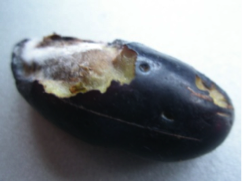 |
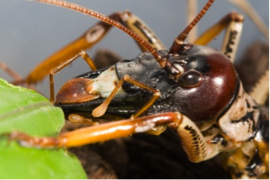 |
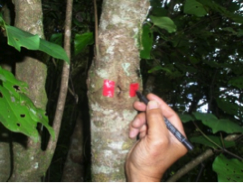 |
PHYSIOLOGY AND BEHAVIOUR RESEARCH
Nutrient ecology and fractionation in tree weta
Determining diet and trophic position of species with stable isotopes requires appropriate trophic enrichment estimates between an animal and its potential foods. These estimates are particularly important for cryptic foragers where there is little comparative dietary information. Nonetheless, many trophic enrichment estimates are based on related taxa, without confirmation of accuracy using laboratory trials. Our results from wild individuals suggest there may be considerable dietary variation both between and within populations based on individual foraging traits and food availability. We now have the foundation to explore the niche breadth of wetas in urban and forest habitats,using tested trophic enrichment values in a range of tissues. Mean tissue fractionation of δ13C and δ15N in the Auckland tree weta, a large herbivorous insect.
Wehi P.M., Raubenheimer D. & Morgan-Richards M. in prep. Nutrient intake in a sexually dimorphic insect genus.
Wehi P.M. & Hicks B.J. 2010. Journal of Insect Physiology 56: 1877–1882. |
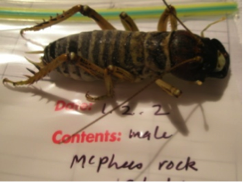 |
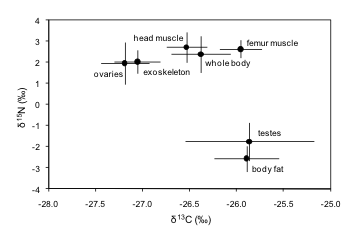 |
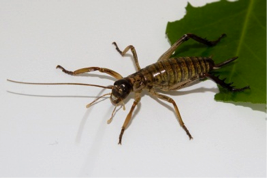 |
Hormonal correlates of dominance in male brushtail possums (Trichosurus vulpecula), and their implications for potential biocontrol methods.
Concern about the impact of introduced brushtail possums (Trichosurus vulpecula) on indigenous flora has led to the classification of possums as pests of national importance in New Zealand. Biocontrol measures aiming to modify the reproductive success of these animals were investigated. In this study, the relationship of male rank to circulating testosterone and cortisol concentrations in captive possum triads was examined. Experiments were carried out to determine hierarchy formation and the effects of hierarchy disturbance during the breeding season. It was found that dominant male rank was significantly correlated with higher levels of circulating testosterone during periods of hierarchy formation and during the breeding season but not during periods of hierarchy stability in the non-breeding season. There was no statistically significant difference in plasma cortisol concentrations (marking stress) of differently ranked possums during the trials, although subordinate males did tend to have slightly higher concentrations than dominant males. Any biocontrol measures that rely on manipulation of hormone levels may be unreliable when applied to unstable hierarchical situations. These situations may, for example, include times when sub-adult males are establishing territories or when, during the pre-breeding season, a period of hierarchy establishment may accompany a peak in circulating testosterone concentrations in males.
Wehi P.M., Barrell G.K. & Hickling G.J. 2006. Ethology 112: 639-648.
Jolly, S. E., Scobie, S., Spurr, E. B., McAllum, C. & Cowan, P. 1998. Royal Society of New Zealand Miscellaneous Series 45: 125-127.
|
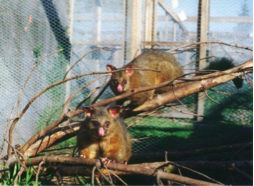 |
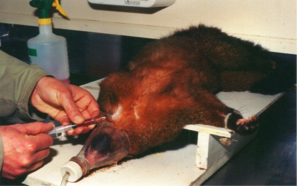 |
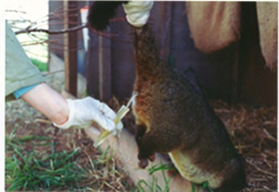 |
CULTURAL ECOLOGY RESEARCH
Indigenous agroecology. University of Otago. A new project! Led by Dr Marion Johnson at the Centre for Sustainability, Agriculture, Food, Energy and the Environment (CSAFE), University of Otago. http://www.csafe.org.nz/food_agriculture.
Molecular and isotope ecology, and museum artefacts.
Museum collections are increasingly subjected to scientific scrutiny, including molecular, isotopic and trace element analyses. Recent advances have extended analyses from natural history specimens to historical artefacts. We highlight three areas of concern that can influence interpretation of data derived from museum collections; sampling issues associated with museum collection use, methods of analysis, and the value of cross referencing data with historical documents and datasets. We use a case study that focuses on kiwi (Apteryx spp.) feather samples from valuable 19th century Māori cloaks in New Zealand to show how sampling and analysis challenges need to be minimised by careful design. We argue that aligning historical records with scientific data generated from museum collections significantly improves data interpretation.
Wehi P.M., Whaanga H. & Trewick S. 2012. Molecular Ecology. Now online.
|
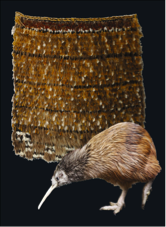 |
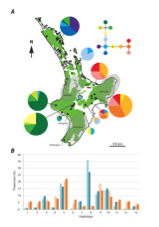 |
Harakeke (Phormium tenax) ecology and historical Māori resource management: The changing landscape in New Zealand.
School of Māori and Pacific Development and the Centre for Biodiversity and Ecology Research, University of Waikato. Doctoral research aimed at understanding the ecology of a culturally important plant (Phormium tenax) and the contribution of traditional indigenous management to landscape change. Understanding past ecological relationships, management regimes and the environmental requirements of plants is important for ecological restoration projects.
This research project investigated Māori knowledge of Phormium tenax ecology and management practices prior to the early 20th century within the context of a study of relevant environmental parameters that limit its natural distribution. To predict outcomes of restoration management actions, studies of present-day patterns must be complemented by investigations of past ecological patterns and processes. Evidence from traditional oral knowledge passed on by kaumātua from Kāwhia and Ngāpuhi, as well as mentors at Te Pua Wānanga ki te Ao, was combined with evidence from the 19th and early 20th century literature (in English and Māori) to support the hypothesis that Māori have managed harakeke (P. tenax) extensively throughout much of the country. Investigation of environmental parameters for harakeke (and wharariki (P. cookianum)) revealed that these species occupy distinct, but broad ecological niches, and predictive modelling of environmental parameters for Phormium in the northern region of New Zealand allowed me to determine where there is the highest probability of finding natural populations. Human directed movement of both flax and wharariki has taken advantage of these broad parameters to disperse varieties to areas not previously colonised by these plants.
Wehi P.M. 2009. Ecological Applications 19:267–275.
Wehi P.M., Whaanga H. & Roa T. 2009. Journal of the Royal Society of New Zealand 39: 139-149.
Wehi P. M. & Clarkson B. D. 2007. New Zealand Journal of Botany 45: 521- 544.
Wehi P. M. 2006. Journal of Maori and Pacific Development 7 (2): 39-44.
McAllum P.M. 2005. Journal of Maori and Pacific Development 6 (1): 2-15.
|
 |
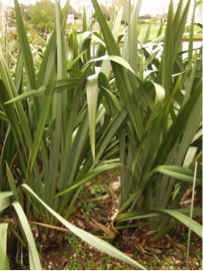 |
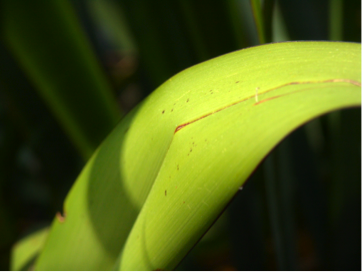 |
Cultural plant use in the western Waikato
The aim was to identify plant species that are commonly harvested by Maori, and to consider which of these species may require conservation management in relation to the Waikato Conservancy Plant Conservation Strategy. January and April 2006. We examined plant use amongst a group of Māori living in the western Waikato to determine which species are actively used, and which other species may be considered culturally important. Research participants were interviewed in detail about the plants they harvested and methods of harvest. I also quantified data from plant collecting permits issued by DOC in the Waikato for the years 2000-2006 prior to making recommendations about future planning and harvesting requirements.
Funder: the Department of Conservation, Hamilton.
Wehi P.M. & Wehi W.L. 2010. Conservation Biology 24: 594-604.
|
 |
 |
 |
URBAN ECOLOGY
Urban restoration and indigenous landcover fragmentation in New Zealand cities (with Prof. Bruce Clarkson and Dr. Lars Brabyn, University of Waikato). Postdoctoral research aimed at providing restoration science that has the capacity to effectively mitigate and/ or avert the biodiversity losses caused by cities and their inhabitants.
The overall aim of this research was to undertake the first meta-analysis of indigenous landcover in New Zealand cities, quantifying patterns of urban indigenous landcover that can be used as a surrogate for biodiversity, and identifying the implications of these patterns for biodiversity restoration. Both population and species loss can be driven by land transformations associated with urbanisation. The challenge for conservation is to manage complex urban landscapes in a way that retains and enhances biodiversity value. We quantified patterns of indigenous landcover from two national databases (LENZ and Landcover2) along an urban-rural gradient, and designed and analysed a restoration questionnaire addressed to council staff of New Zealand’s 20 largest cities (with a 90% respondent success rate). We investigated how the analysis of national patterns of urban land environments, indigenous cover and remnant ecosystems could be used to (a) support action at a regional and local level, and (b) enhance national and global biodiversity goals.
Mackay D.B., Wehi P.M & Clarkson B.D. 2009. Urban Habitats 6: online journal. http://www.urbanhabitats.org/v06n01/hamilton_full.html.
Clarkson B.D., Wehi P.M. & Brabyn L.K. 2007. Urban Ecosystems 10: 441-457.
Cornes T., Wehi P.M. & Clarkson B.D. 2008. Waiwhakareke experimental plots. http://cber.bio.waikato.ac.nz/publications.shtml/
Cornes T., Wehi P.M. & Clarkson B.D. 2008. Waiwhakareke monitoring plots. http://cber.bio.waikato.ac.nz/publications.shtml/
Clarkson B. D., Wehi P.M. & Brabyn L.K. 2007. Bringing nature back into cities: urban land environments, indigenous cover and urban restoration. http://cber.bio.waikato.ac.nz/publications.shtml/ |
POPULATION ECOLOGY
Weta in urban forest patches (with Dr Chrissen Gemmill and Asoc. Prof. Brendan Hicks, University of Waikato). Centre for Biodiversity and Ecology Research, University of Waikato.
There is widespread recognition that spatial patterns such as habitat fragmentation affect ecological processes. However, landscape ‘variegation’ which describes modified habitats, such as the urban matrix surrounding remnant indigenous fragments, is not necessarily hostile to all native organisms. Management of exotic cover can have beneficial effects for indigenous species. Thus, for example, weta (Hemideina thoracica: Orthoptera) have, unlike many New Zealand native species, successfully colonised the urban garden matrix and may therefore be more resilient than species with specialised ecological niches. They may, however, be disadvantaged in isolated urban forest fragments where such fragments are surrounded by mown grass parks that are difficult to traverse. We examined seasonal patterns in their habitation of artificial cavities in an urban forest fragment, and investigated diet breadth in urban forest fragments compared to entire forests in the Waikato.
Wehi P.M., Jorgensen M. & Morgan-Richards M. (in revision). Sex and seasonal movement in a flightless forest insect the Auckland tree weta. |
Condition dependent dispersal in Tetrahymena populations (with Dr. Alexis Chaine and Dr. Jean Clobert, CNRS). Station d'Ecologie Expérimentale du CNRS, Laboratoire Evolution et Diversité Biologique, Moulis, France. Postdoctoral research centred on the themes of cooperation, dispersal between populations, and the evolution of dispersal phenotypes. September-December 2008.
Colonisation is the crucial process underlying range expansions, and is, for example, a vitally important process in fragmented landscapes. Dispersal is the first key step in colonisation, but successful dispersers are not always the most successful colonisers. Thus, there may be differences in the life histories of dispersing versus philopatric individuals. Dispersal will also impact local adaptation. Artificial microcosms and genetically alike organisms with short generation time are one of the best ways to investigate genetic syndromes and differences in dispersal. Microorganisms are therefore ideal organisms for studies on co-variation between dispersal and life histories. Tetrahymena thermophila is a unicellular, ciliated protozoan that feeds on bacteria and dissolved nutrients in American freshwater ponds and streams. Tetrahymena thermophila cells also form aggregations, are morphologically plastic and secrete substances favouring the survival of other cells, so the species is ideal for study of the evolution of dispersal strategies and kin benefits and competition. We measured variation in density dependent dispersal among individuals in aggregative and dispersal strategies. In experimental manipulations with six genetically distinct lines of Tetrahymena, we compared morphologies, levels of aggregation, and ability to colonise new habitat to determine whether a dispersal-aggregation trade-off exists.
|
|